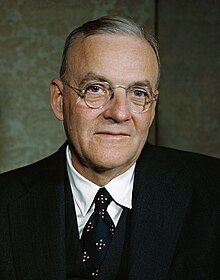John Foster Dulles | |
|---|---|
 Dulles, c. 1949 | |
| 52nd United States Secretary of State | |
| In office January 26, 1953 – April 22, 1959 | |
| President | Dwight D. Eisenhower |
| Preceded by | Dean Acheson |
| Succeeded by | Christian Herter |
| United States Senator from New York | |
| In office July 7, 1949 – November 8, 1949 | |
| Appointed by | Thomas E. Dewey |
| Preceded by | Robert F. Wagner |
| Succeeded by | Herbert H. Lehman |
| Personal details | |
| Born | February 25, 1888 Washington, D.C., U.S. |
| Died | May 24, 1959 (aged 71) Washington, D.C., U.S. |
| Resting place | Arlington National Cemetery |
| Political party | Republican |
| Spouse |
Janet Pomeroy Avery (m. 1912) |
| Children |
|
| Relatives | Dulles family |
| Education | Princeton University (BA) George Washington University (LLB) |
| Signature |  |
| Military service | |
| Allegiance | United States |
| Branch/service | United States Army |
| Years of service | 1917–1919 |
| Rank | Major |
| Battles/wars | World War I |
John Foster Dulles[a] (February 25, 1888 – May 24, 1959) was an American politician, lawyer, and diplomat who served as United States secretary of state under president Dwight D. Eisenhower from 1953 until his resignation in 1959. A member of the Republican Party, he was briefly a U.S. senator from New York in 1949. Dulles was a significant figure in the early Cold War era, who advocated an aggressive stance against communism throughout the world.
Born in Washington, D.C., Dulles joined the leading New York law firm of Sullivan & Cromwell after graduating from George Washington University Law School. His grandfather, John W. Foster, and his uncle, Robert Lansing, both served as U.S. secretary of state, while his brother, Allen Dulles, served as the director of central intelligence from 1953 to 1961. Dulles served on the War Industries Board during World War I and he was a U.S. legal counsel at the 1919 Paris Peace Conference. He became a member of the League of Free Nations Association, which supported American membership in the League of Nations. Dulles also helped design the Dawes Plan, which sought to stabilize Europe by reducing German war reparations. During World War II, Dulles was deeply involved in post-war planning with the Federal Council of Churches Commission on a Just and Durable Peace.
Dulles served as the chief foreign policy adviser to Thomas E. Dewey, the Republican presidential nominee in 1944 and 1948. He also helped draft the preamble to the United Nations Charter and served as a delegate to the UN General Assembly. In 1949, Dewey appointed Dulles a U.S. senator for New York. Dulles served for four months before his defeat in a special election. Despite having supported his political opponents, Dulles became a special advisor to president Harry S. Truman, with a focus on the Indo-Pacific region. In this role from 1950 to 1952, he became the primary architect of the Treaty of San Francisco, which ended World War II in Asia, the U.S.–Japan Security Treaty, which established the U.S.–Japan Alliance, and the ANZUS security treaty between Australia, New Zealand, and the United States.
In 1953, President Eisenhower chose Dulles as secretary of state. Throughout his tenure, Dulles favored a strategy of massive retaliation in response to Soviet aggression and concentrated on building and strengthening Cold War alliances, most prominently NATO. He was the architect of the Southeast Asia Treaty Organization, an anti-communist defensive alliance between the U.S. and several nations in and near Southeast Asia. He also helped instigate the 1953 Iranian coup d'état and the 1954 Guatemalan coup d'état. Dulles advocated support of the French in their war against the Viet Minh in Indochina, but rejected the Geneva Accords between France and the communists, instead supporting South Vietnam after the 1954 Geneva Conference. In 1959, suffering from cancer, Dulles resigned from office and died shortly after.
Cite error: There are <ref group=lower-alpha> tags or {{efn}} templates on this page, but the references will not show without a {{reflist|group=lower-alpha}} template or {{notelist}} template (see the help page).